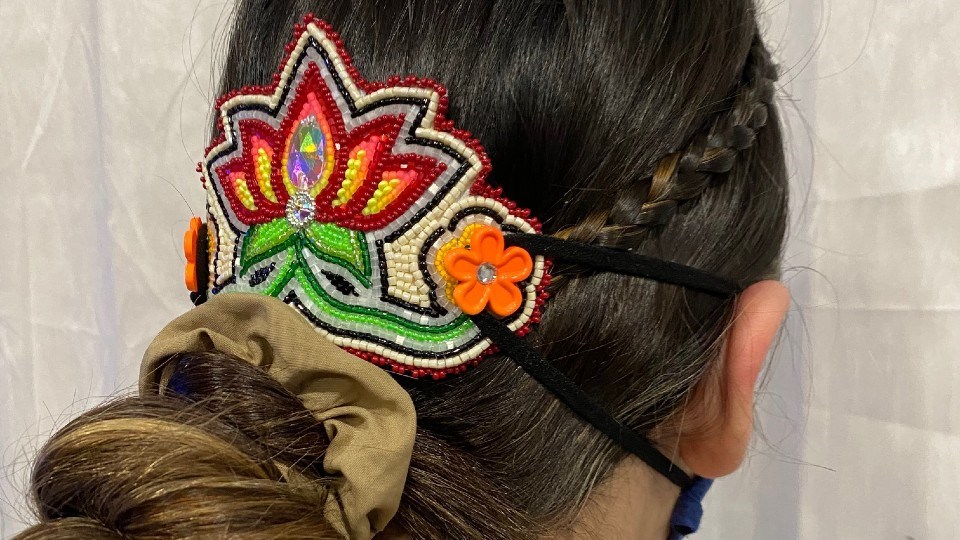Tara Kiwenzie, artist and Ojibwe-Kwe from Wiikwemkoong Unceded Territory, has been beading and crafting for more than 20 years. She comes from three generations of crafters.
And she got an idea when she read about someone’s ears hurting.
It’s an odd but realistic outcome of adding masks to our everyday lives, some spending a majority of the day with strips of elastic digging in their ears under the guise of holding it on your face.
But if you’ve ever had a Janet-Jackson-at-the-Superbowl moment when your mask’s elastic slipped off and instantly revealed your naked face, you know that even if your ears don’t hurt, they don’t always work well either.
And so, one of the more inventive aspects of the pandemic has been the sheer number of ‘ear savers’ that have come to creation. From small buttons on glasses to random strips to fabric, the design is purely practical.
But not for Kiwenzie. With the eyes of someone who knows crafts, who comes from crafters, she saw the chance to offer a solution. ‘Ear Saver’ barrettes, beaded with the spirit seeds of energy and protection, and offered in designs so beautiful it could be a shame that it is on the back of your head.
“I was sitting on the idea since the fall of last year,” said Kiwenzie. “I had a Safari (browser) tab on my phone that had ‘crochet ear savers’ after reading a ton of people complaining about their ears hurting. My husband does this thing to me all the time where he says ‘I bet you could bead that,’ or 'you should bead that.' So I thought to myself after seeing the crochet ones, 'I bet I could bead that’.”
So she did.
Of course, it takes about 18 hours to make one.
Not only is it time-consuming and highly detailed work, but one that requires the beader be in the right frame of mind. When you bead with Spirit beads — Manidoo-Minenhnsag— you must be more aware of your mood and energy when crafting, otherwise that is the energy that will enter the work.
“The conditions that I bead in are always positive,” said Kiwenzie. “If there is something negative going on I will take a break from beading, my husband will smudge the whole house and my work area then once I feel better I get back to it. I do all those things because I truly believe that your energy goes into everything you make, so I want my customers to feel the positive feelings when wearing my art.”
As well, just because the pandemic created the need for ear savers, doesn’t mean it also freed up the time to make them.
“My family has been pretty resilient in these tough times,” said Kiwenzie. “But I did take a break for a while when there was a lot of uncertainty. I felt a bit lost but when I started to find my footing again, I found it was beading that kept my mind in that positive place. At first I only had a small amount of time to get creative but my whole family adapted to the new routine so I find I can get a little more done now.”
It is a time-consuming process, but it shows in the work. Each one is beautiful in its own way, and made to be worn long after the need for masks in every public place.
And it is one that allows Kiwenzie to continue practicing the craft she and her family love. “My brother and I actually began by doing loomwork when we were around age of 10, then we learned the other beading techniques to bead our regalia items by the age of 15,” said Kiwenzie. “I learned how to bead from my parents, (and) I am a third generation of artists on both sides of my family. In the future, I would love to expand my art to more traditional mediums. My grandmother used to make birch bark canoes with sweetgrass and red dyed quills. I remember helping her when I was very young, so to come full circle is a goal for myself.”
Tara Kiwenzie Designs can be found on Facebook, at Tara Kiwenzie Designs.
But the artist asks that you ensure it is her you are dealing with. “I’ve been caught up in scammers recently and I would just like my customers to be careful. Message (her) if you’re unsure.”
Jenny Lamothe is a Local Journalism Initiative reporter at Sudbury.com. She covers the Black, Indigenous, immigrant and Francophone communities.
